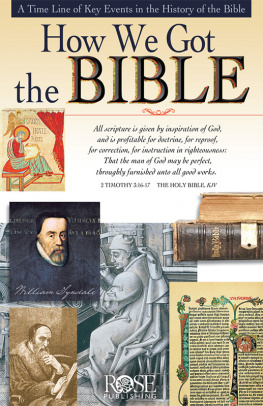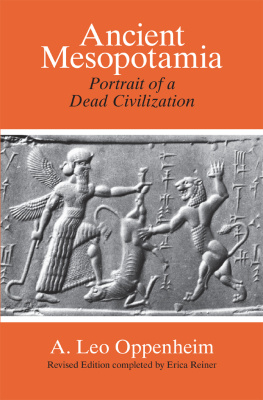This Dover edition, first published in 1982, is an unabridged and unaltered republication of the work originally published in 1953 under the title The Hand-Produced Book.
Library of Congress Cataloging in Publication Data Diringer, David, 1900-
The book before printing.
Reprint. Originally published: The hand-produced book. London : Hutchinsons Scientific and Technical Publications, 1953.
Includes bibliographies and index.
1. BooksHistory400-1400. 2. PrintingHistory. 1. Title.
Z6.D57 1982
81-17290
9780486142494
AACR2
Manufactured in the United States by Courier Corporation
24243907
www.doverpublications.com
Table of Contents
PREFACE
THE results of many years research into the history of the book are here presented. While many of the facts mentioned have been known for some time, there is much information that is believed to be new and, so far as the author is aware, these facts and the conclusions to be drawn from them have never previously been brought together. The history of the book is one of the most fragmentary chapters in the history of civilization, however great the gaps may be in other fields of research. It is, indeed, remarkable thatnotwithstanding the enormous number of publications on particular aspects of the development of the bookvery few comprehensive histories of the book have appeared in English during the last fifty years, a period of unexampled progress in many fields of knowledge. Some of the discoveries during this period have completely reversed the ideas concerning the history of the book current about the beginning of the century. Of late years we have learnt much regarding the antiquity of writing and of book production, and it is of primary importance to study the earliest records in the light of modern research. In almost every department of science the theories of yesterday are refuted by facts of today, though the ascertainment of these facts has frequently been aided by those very theories. So it is that, in the main, the works of the greatest scholars and experts have no finality; they are but stepping-stones towards the high goal of perfect knowledge.
Naturally the authors own theories must inevitably colour his presentation of facts, but so far as is known this has never been allowed to lead to any distortion for the sake of supporting a favourite thesis. In stating facts preference has been given to the actual words of the authors quoted. Since the main purpose of this volume is to provide a handy and up-to-date work of interest to the general reader, the author has not thought it necessary in all instances to supply precise references for his quotations. It has hardly been possible within the limits prescribed to do more than stimulate interest by providing sufficient information for the inquiring reader. The latter will probably wish to follow particular developments in greater detail. To meet this need, long lists of books, some dealing fully with a particular period or subject, others dealing with the field as a whole, are given after single chapters or sections, or at the very end. Indeed, the subject is much too rich to be exhausted in one or two books, and the present volume may serve as a guide for future research.
Inevitably a certain amount of information is given on the contents or the literary aspect of some of the manuscripts mentionedparticularly in the generally less known departmentsbut this work is not intended as a review of the worlds literature, and the contents are referred to mainly as being examples of the common phenomenon of the influence of the contents on size, shape and presentation.
Writing materials, from the hammer and chisel to the paintbrush and the pen, from stone to clay, to papyrus and parchment, have commanded a fair amount of space, and it would be unfortunate to ignore entirely the human side or some of the stories about the men whose work has culminated in the modern book as we know it. Naturally many of the books mentioned are hardly books in the modern sense, but a certain amount of latitude in the use of terms must be permitted.
The present work is another step in the plan outlined in the authors The Alphabet, A Key to the History of Mankind, in which it was indicated that the story of the alphabet would in due course be followed by a history of the development of writing. It is perhaps unfortunate that it has been found impossible to cover the whole story of the book in one volume, but the first of the two volumes now presented tells the story of the hand-produced book from the earliest times to the invention of printing, and the second volume will cover illumination and binding of the hand-produced book.
Of the ten chapters of the volume, chapters IV-VII tell the main story. Chapter i is something of an introduction. Chapter n deals with a subject of material importance from the point of view of the development of the book, but is not in itself a part of the history. Chapters III, VIII and ix deal with these parts of the history which are aside from the main line of development of the book as we know it. The long chapter x has been written mainly for the English reader. If the present work is translated into other languages
Italian, French, German, Spanish, Dutch, and so onit would be the authors desire to add a chapter on the development of the book in the country concerned.
Unavoidably, a book of this kind is bound to contain a certain amount of repetition, but this has been reduced to a minimum and is usually more apparent than real; indeed, the same subject matter, if dealt with more than once, is usually presented from a different angle.
In the spelling and transliteration of Egyptian, Semitic, Indian, Chinese, Greek and other foreign words, especially place-names and proper namesas already pointed out in the Preface to The Alphabet inconsistencies in a composite work such as this are unavoidable, and the general reader should understand that a quite satisfactory solution of the problem has not been found. The practice commonly adopted has in general been followed, but here and there consistency is sacrificed to the idea of presenting to the reader familiar names in their familiar forms. And since in any case inconsistency is unavoidable, certain spellings have been simplified where no confusion is likely to result. Although in some cases divergent transliterations may cause difficulties, it is reasonable to assume that general readers are indifferent to what experts know, while experts do not always agree as to the precise spelling.
As one might expect, there is a long list of people to whom the author is indebted. It seemed advisable to have all sections carefully checked by experts in the respective fields. Some of these are mentioned in the list of acknowledgements, but perhaps some should be included here, such as Professors A. J. Arberry and H. W. Bailey, Professors B. Dickins and W. F. Edgerton, Dr. I. Gershevitch, the late Prof. G. Haloun, Prof. T. Kamei, Sir Thomas Kendrick, Prof. M. C. Knowles, Messrs. J. Leveen and C. Moss, Professors R. A. B. Mynors, J. M. de Navascus and D. L. Page, Messrs. J. M. Plumley and R. M. Rattenbury, the Hon. S. Runciman, Prof. J. M. C. Toynbee, Messrs. P. van der Loon, G. M. Wickens and D. J. Wiseman, and Prof. F. Wormald. Gratitude is expressed to Mrs. Hilda Freeman and to Messrs. L. A. Freeman, and C. E. Vulliamy, who carefully read the whole book in manuscript, and made many valuable criticisms and suggestions. The suggestions made by various experts often concerned debatable questions which, in this book, the author has endeavoured to reduce to a minimum.
It is impossible for the author to express adequately his most sincere gratitude to all the librarians and others who have collaborated in the production of this volumefirst and foremost to the following scholars: Abbot Anselmo Maria Albareda, Prefect of the Vatican Library; Prof. H. W. Parke and M. J. Hanna, resp. Librarian and Assistant Librarian of Trinity College, Dublin; Dr. R. J. Hayes, Director of the National Library, Dublin; Dr. R. W. Hunt and Dr. A. F. L. Beeston, Keepers, resp., of the Western and the Eastern Manuscripts of the Bodleian Library, Oxford; the staff of the University Library, Cambridge; Dr. Irma Tondi-Merolle, Director of the Riccardian Library, Florence ; Dr. P. Calisse, Secretary of the Enciclopedia Italiana, Rome; Prof. D. T. Rice, University of Edinburgh; Prof. J. Weingreen, Mlle F. Henry, Dr. L. Bieler, and other scholars of the two University colleges of Dublin.









